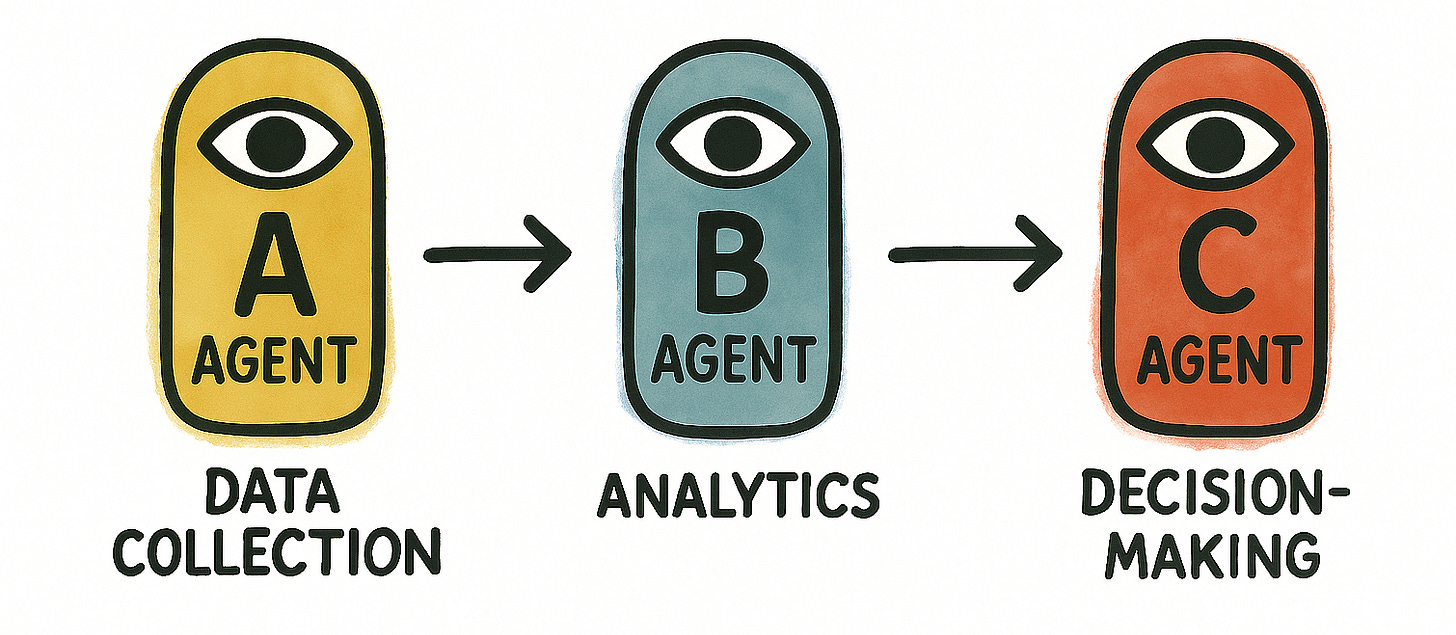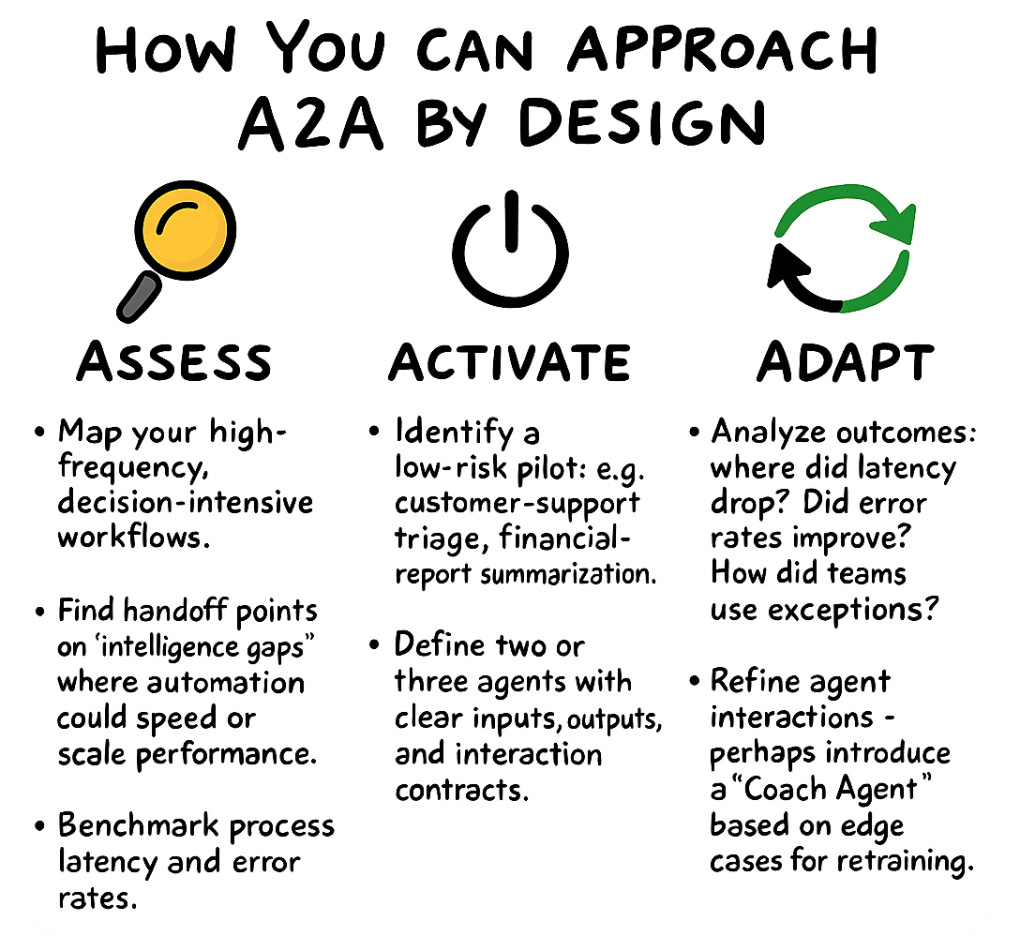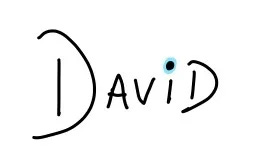In the not-too-distant future, we will be designing interfaces, experiences, content, code, and entire strategies—not just for people, but for AI-enabled autonomous agents. Think about that for a second. The end user isn’t always human anymore. We’re writing for AI, Coding for AI, and AI agents will be handling increasingly complex tasks, passing them off to each other like a collaborative human team. A developing buzz phrase has started surfacing to describe this shift: “A2A” or Agent-to-Agent, like a remix of B2B, but for a world where intelligent software talks to other intelligent software to get things done.
Simply put, A2A refers to systems where autonomous agents communicate, collaborate, and coordinate tasks directly with one another. They can fetch data, run analyses, make decisions, and pass outcomes along to the next agent in the chain—all without waiting on human input. This is a massive shift in how work gets done and how we, designers, technologists, and strategists, must think about what we’re building—and for whom.
What is “A2A” or Agent‑to‑Agent?
Imagine a conversation—not between people but between purpose-built software beings. These agents are autonomous software modules with their own goals and capabilities. They observe, decide, and act—and most importantly, they communicate with each other without needing a human to bridge the gap.
In the A2A world, one agent might specialize in data collection, another in analytics, and a third in decision-making. Together, they orchestrate outcomes. Think of it like a remote-control relay race: each runner (agent) has a handoff moment and a specific segment to accelerate. Collectively, they accomplish something much bigger than any could solo.
What Will A2A Impact?
A2A isn’t just coming—it’s already showing early value in several industries:
Finance
Imagine connected trading bots—one monitoring market triggers, another evaluating risk, a third executing cross-border trades. You get round-the-clock, autonomous coordination with built-in checks and balances.
Supply Chain & Logistics
Picture the “Route Optimization Agent” handing off to the “Carrier Negotiation Agent,” which then delegates to the “Tracking & Alert Agent.” They reduce delays, manage exceptions, and coordinate responses seamlessly across carriers.
Customer Experience
From initial inquiry to resolution, a chain of agents is involved. An “Inquiry Parsing Agent” routes to a “Specialist Agent,” who leverages a “Knowledge Fetch Agent.” Thus, the customer gets faster, more accurate support with limited human oversight.
Healthcare
Early-stage pilots show promise: diagnostic agents flag anomalies, specialist agents recommend tests, and administrative agents manage workflows. That triangle can reduce overhead and improve triage efficiency.
Why Should You Care?
Here’s why Agent-to-Agent matters:
Speed & Scalability: When agents collaborate, tasks like assembly lines allow complex processes to scale faster than monolithic systems.
Resilience & Specialization: A2A enables resilience—if one agent catches an error, another picks it up, like teammates covering each other in fast-moving projects.
Strategic Leverage: You can design for decisions before they reach people, enabling smarter hit rates and reducing noise.
In my estimation, brands and leaders who treat A2A as a strategic design challenge—not a technical gadget—unlock new possibilities. It’s about asking: What if your organization could prototype strategy via A2A bots before it landed in human inboxes? That framing shifts A2A from “cool tech” to “fundamental thinking.”
When Will A2A Mature?
Here’s a view layered into a maturity model:
Today (2025)
R&D teams in tech-forward firms are building prototypes.
Developer ecosystems and open frameworks (e.g., LangChain, AutoGPT-style toolkits) are emerging.
Next 18–36 Months
Early business pilots in targeted functions (finance, ops, CX).
Specialist vendors launch curated A2A modules.
Standards and APIs evolve for interoperability.
3–5 Years Out (2028–2030)
A2A becomes an architecture option in enterprise platforms.
Competitive leaders integrate agent orchestration into digital transformation toolkits.
Governance, compliance, and design-by-A2A become a C-suite strategy discussion.
Prediction: By 2028, A2A agent orchestration will become a core design paradigm, similar to how microservices matured in the 2010s. If you start today, you’ll be ahead of the curve when this becomes standard operating procedure.
Who Are The A2A Players To Watch?
Amazon & Booking Holdings
According to Bank of America's analysis, Amazon and Booking are positioned as early leaders in agentic AI. Amazon’s “Buy-for-Me” and the Rufus chatbot and Booking’s AI Trip Planner are pushing toward end-to-end agent-based services—automating decisions, not just recommendations.
Meta Platforms
Also cited in the same report, Meta is deepening investment in AI agent infrastructure through its assistant platform and a $14.3B deal with Scale AI. With over a billion users, Meta’s footprint makes it a watchpoint for scaled, embedded A2A.
Google (Gemini & Agent-to-Agent Protocol)
During Google Cloud Next 2025, Google revealed its Agent-to-Agent protocol—a move toward standardizing how agents communicate, collaborate, and coordinate. Combined with Gemini’s advancements, Google is laying foundational A2A infrastructure.
KPMG Workbench
KPMG recently launched Workbench, a multi-agent AI platform enabling automated tax, audit, and advisory services workflows. This move signals how professional services are pivoting to A2A operational models.
OpenAI’s AutoGPT
As one of the most visible agent chaining frameworks, AutoGPT allows users to define goals and delegate tasks to autonomous agents, one of the earliest glimpses into continuous A2A task delegation and iteration.
SnapLogic (AgentCreator)
SnapLogic’s AgentCreator offers a low-code environment for chaining agents into complex workflows, which is ideal for IT and business operations teams integrating legacy and cloud environments.
Manus (China)
Manus is a newly launched AI agent capable of generating and deploying code autonomously. It represents a leap toward self-directed, hands-off orchestration for technical teams.
FuseBase
FuseBase is among the first SaaS platforms to embed AI agents across customer portals and internal ops. Its use of the Model Context Protocol allows configurable agent automation within collaborative workflows.
Beam AI
Beam enables agent-based automation for sales enablement, customer support, and HR within Fortune 500 companies, proving that multi-agent orchestration can be enterprise-ready and ops-integrated.
How You Can Approach A2A by Design
Take an A2A by design approach to an interactive agentic system by assessing, activating, and adapting:
Assess
Map your high-frequency, decision-intensive workflows.
Find handoff points and “intelligence gaps” where automation could speed or scale performance.
Benchmark current process latency, error rates, and cost per decision.
Activate
Identify a low-risk pilot: e.g., customer-support triage, financial-report summarization.
Define two or three agents with clear inputs, outputs, and interaction contracts.
Deploy with monitoring—track speed, accuracy, exception rates, and cost savings.
Adapt
Analyze outcomes: where did latency drop? Did error rates improve? How did teams use exceptions?
Refine agent interactions—perhaps introduce a “Coach Agent” based on edge cases for retraining.
Roll successful pilots into broader domains—then repeat the loop.
Use feedback as fuel. This isn’t “set it and forget it.” A2A unleashes a new domain of design thinking where the intelligence network evolves.
From customer service to supply chains, multi-agent frameworks are emerging not as experiments, but as strategic design layers. The implications are massive: we’re no longer designing for people alone. We’re designing for networks of intelligent agents that often interact with each other—and with us—invisibly.
If you’re a senior leader, don’t wait for an “A2A platform” to be handed to you. Start by identifying the high-frequency workflows where agents could offload cognitive load or accelerate decision cycles. Run a small pilot. Learn fast. Iterate.
Humans alone won’t architect this transformational construct. It will be prototyped, stress-tested, and optimized by agents, for agents—and the organizations that understand this first will gain speed, precision, and leverage others won’t see coming.
Design for that.
Visually yours,










Great article, David. Really does a nice job explaining agent-to-agent interplay and architecture.
3–5 years out, more on the latter side, is the right ballpark for this to become a reality. People are still struggling to get basic AI infrastructure and their first agents up. I see the whole automation integration into the workplaces as a longer horizon event than Silicon Valley.
This is great, David. My big thought is that there needs to be a BrandOS encoded into this- without it, brands will vanish. The process to get this done is way more complicated than we've ever done historically for brands, requiring a level of depth and rigor unmatched by past efforts, such as brand guidelines.